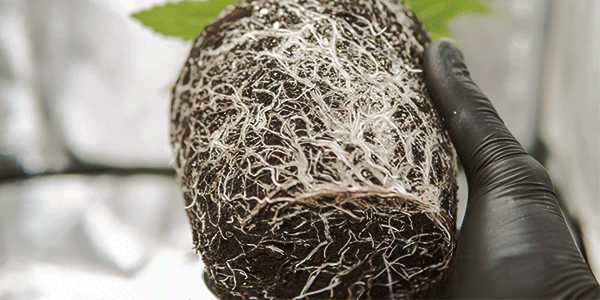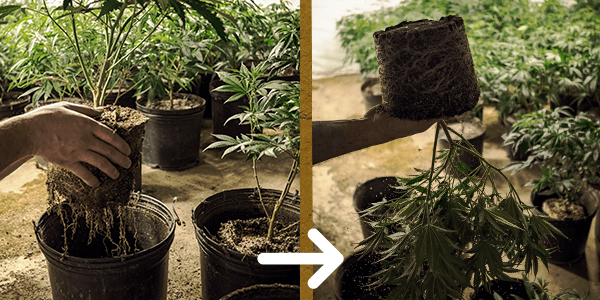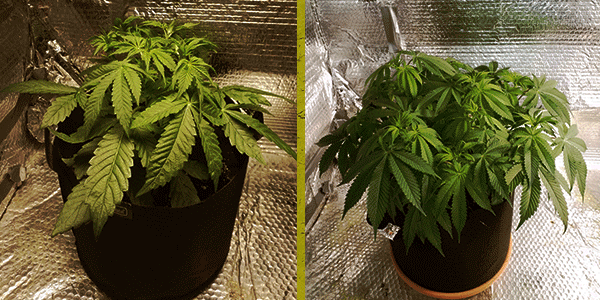How to Rescue Rootbound Cannabis Plants
Published : Dec 3, 2020

Walking around in shoes two sizes too small would get very uncomfortable, very fast. This is how cannabis plants feel when they outgrow their pots. Their roots get tangled, restricted, and bound-up, resulting in deficiencies, a dry growing medium, and stunted growth. Learn how to identify rootbound plants, and how to introduce them to a new home.
Cannabis growers face numerous challenges between germinating seeds and harvesting their bounty. Among pest issues and environmental factors, rootbound plants can cause several problems that may affect overall growth and yield. Below, you’ll learn everything you need to know about bound cannabis roots, how it affects growth, and how to remedy it.
How Cannabis Plants Become Rootbound
In nature, cannabis grows by its own rules. Wild landrace strains will happily grow anywhere from the Kush mountains to concealed Jamaican pastures. These specimens develop complex root networks deep in the ground that team up with countless microorganisms and anchor the plant in place.
In contrast, domesticated cannabis strains are typically subject to drastically different growing conditions. Plants grown in containers or even raised beds sometimes begin to feel a little confined. If their roots run out space, they start to bend, turn, and even double-back on themselves.
Eventually, the roots will fill in almost all of the available space. In doing so, they conform to the container in which they are limited. This leads to incredibly dense root balls that take on the shape of their pot—from cylindrical columns to cuboid structures.
Although an impressive display of adaptation, rootbound plants can suffer from numerous conditions and are predisposed to factors that limit their potential. Their roots expand further afield in nature for a reason, and they’re not too keen on being bundled up.

Constricted root systems form for several reasons; here are the two most common.
A Result of Stealthy Growing
Many covert growers will do everything they can to keep attention away from their botanical activities. This often involves cultivating plants in small pots for the entirety of their life cycle. Although some growers obtain decent results with this method, the bound-up root system may present some problems during the grow.
Poor Transplant Timing
Cultivators who mistime transplants are also likely to see their plants in a rootbound state. For photoperiod plants, it’s recommended to move them up through a series of increasingly larger pot sizes throughout their life cycle.
This means the size of the container should provide a “goldilocks zone” at each stage—not too big to allow water and nutrients to escape, and not too small to cause a bound-up root system. However, misjudging when to pot-up can leave plants swiftly outgrowing their containers and getting their roots in a tangle.

Signs of Rootbound Cannabis Plants
Of course, it’s quite difficult to determine exactly what’s happening under the surface of the soil. Plus, tearing away topsoil to take a peek into the root zone does more harm than good. However, there are a few signs and symptoms to keep an eye out for that might indicate a bound root system. Check out the most common below.
Symptoms of Nutrient Deficiency
Cannabis plants require certain amounts of macronutrients and micronutrients to stay in good health and perform at their best. A deficiency of a particular nutrient will lead to telltale signs such as yellowing, dropping, browning, and curling leaves, and other indicators. Various factors can underpin these deficiencies, including a bound root system.
As the root system becomes denser, it’ll uptake more nutrients. As the demand for nutrients becomes higher—but the size of the container remains the same—plants will strip the growing medium of minerals much faster. Rootbound plants may then begin to show signs of deficiency, as growers are unaware they are underfeeding a large root mass that resides under the surface.

Rapidly Drying Growing Medium
When did you last water your plant? If your specimen received water only a day ago, yet seems incredibly dry—you might be tending to a rootbound plant. Much like how nutrient deficiencies arise in the same situation, the root mass will drink up any water it has access to as quickly as possible. If the root mass outgrows the growing medium, it’ll dry out extremely fast, and your plant will probably be left thirsty.
Be sure you’re watering your plants correctly. Water them slowly and thoroughly instead of dumping water into the container. A slow and steady stream will adequately hydrate the root system. If your plants still seem dry after watering with this method, you should consider the state of their roots and the size of the container as a cause.
Unusually Heavy Plants
You should have a good idea of how heavy your plants are throughout the growing season. You can check their weight simply by lifting up the container. Not only does this help to determine when to water them again, but it can also give you an indication of the increasing density of the root system. If your potted plant seems unusually heavy even when dry, it might be time to pot on and let those roots free.
A Clear Disparity Between Pot and Plant
Simply use your eyes for this one. If your plant looks obviously too large for its container, you need to pot it on—unless done intentionally in the name of stealth. When your plants become substantially wider than their pots, move them to the next size up.

Stunted Growth
Different strains will grow to different heights and widths. If you notice your plants look much smaller than they should be, they’re likely residing in an undersized container. Slowed or stunted growth signifies that the root system has stopped growing laterally and is probably bound and restricted.
How to Fix Rootbound Cannabis Plants
Identifying the problem is the first step to fixing a rootbound plant. Once you’ve discovered the “root cause” of the issue, you can make moves to remedy it. Because a lack of space underpins the condition, increasing the size of the container is the next logical step.
Follow the simple steps below to liberate your rootbound plants and ease them into their new homes.
Step 1: Optimise the Growing Medium
You’ll need to make sure the growing medium reaches an optimal consistency before transplanting. Too wet or too dry, and the soil will crumble or break up during the transfer, leaving the roots far more stressed and exposed than necessary. Water your plants two days before you make the transplant. This will keep moisture content in the sweet spot and make the task as easy as possible.
Step 2: Prepare the New Container
Before you remove your plant from its old pot, you need to prepare its destination. Grab a larger pot and fill the bottom with a high-quality organic potting mix. Aim to fill the pot up enough so that the base of your plant doesn’t exceed the height of the rim of the new pot. Water the soil in the new container to make the pot as welcoming as possible—minimising transplant shock and subsequent slowed growth.
Step 3: Liberate Your Plant
First, give the container a firm squeeze along the entire diameter. Applying pressure from opposite sides of the pot will loosen up the root ball, dislodge the growing medium, and reduce the amount of friction you need to extract your plant.
Next, place your hand over the top of the growing medium with the stem loosely between the base of your middle and ring finger. Tip the pot upside down into your hand and slowly lower it out of its old container.
Once free, orientate your plant upright. Gently start to squeeze the root ball and untangle any large roots where possible. Although this might seem heavy-handed, loosening up the bound root system will help it expand into its new home.
Step 4: Moving in
Place your plant into the centre of its new container. Pour additional soil down the side of the root mass until you reach the base of your plant. Pack the soil down as you go and make sure it feels firm when finished. Water your plant to minimise transplant stress and place it back into the same environment it was growing in before.
Fixing Rootbound Weed Plants: An Easy Solution to a Common Problem
The idea of a tangled and bound root system worries a lot of cannabis growers. Sure, rootbound plants can develop conditions that reduce yields and damage plant health; but luckily, identifying a rootbound plant largely relies on common sense. Keep an eye on the size of your plant and any obvious deficiencies. If your plants do become rootbound, all it takes is a good transplanting job to get them back on track.






































